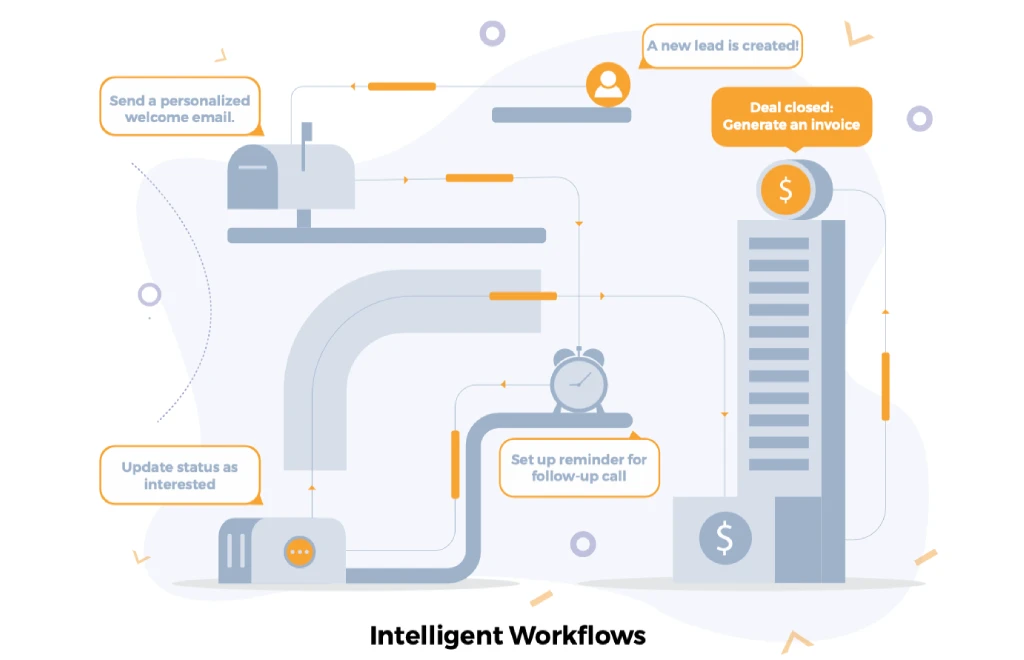What Is Workflow: Types, Elements and Examples
If you’re seeking to create more organization and efficiency in the way your team operates, the workflow must be a word on your mind.
Perhaps you’re searching for workflow software or comprehensive workflow management systems to streamline a problematic process.
Alternatively, you might be looking to persuade your team about the advantages of implementing a workflow to save time and prevent errors. Regardless of your motive, we’re here to help.
In this article, we’ll explain: what is workflow and why it matters, along with the key elements to create an effective workflow.

Free eBook: Solutions for Project Managers’ time tracking pain points
Download a free Project Manager’s handbook on time tracking
What is workflow? Definition
In essence, a workflow is a sequential set of tasks that need to be accomplished to achieve a particular goal — it’s how the work flows, get it?
It consists of a set of interconnected processes that determines the most efficient method to carry out the work by outlining the tasks, assigning responsibilities, and estimating the time required for each task.
A workflow can be a visual representation of the process or a written document as long as it outlines the steps necessary to complete that task.

Workflow example
Let’s take the process of submitting an expense report to a company. The workflow may include the following tasks:
- An employee gathers all receipts for the expenses incurred.
- Employee submits an expense report form with the required details, such as the purpose of the expenses, date, and amount.
- The manager checks the form for accuracy and compliance with company policies. If everything is in order, the approved expense report is forwarded to the accounting department for payment processing.
- The accounting department verifies the expenses and issues the payment to the employee.

Free eBook: Solutions for Project Managers’ time tracking pain points
Download a free Project Manager’s handbook on time tracking
As you can see, this workflow outlines a set of sequential tasks that need to be completed to reimburse employee expenses while ensuring compliance with company policies.
It also defines the roles and responsibilities of each party involved in the process.
Did you know that creating and organizing workflows may be the project manager’s responsibility?
Types of workflow
There are three primary categories of workflows you can use in your work: Process Workflow, Case Workflow, and Project Workflow.
Process workflow
Firstly, the process workflow is the most popular business workflow. It happens when you have a set of repetitive and predictable tasks to handle.
As it’s always the same, you always know how this workflow will end, even before it starts — it’s quite straightforward.
This type of workflow is designed to manage an infinite number of items that go through them. The expense submission workflow we talked about before is a great example.
Once initiated, the process workflow configuration remains fixed with minimal deviations, also enabling handling multiple items within a single workflow instance.
Case workflow
Secondly, the case workflow serves as a workflow management solution that establishes a starting point but does not have a predefined endpoint at the outset. The pathway unravels as data emerges.
Cases, such as support tickets and insurance claims, are good examples of the unpredictable nature of their processing pathways. The path only unfolds after a thorough examination.
Unlike process workflows, case workflows require human or intelligent bot intervention to determine the correct course of action. Despite this, case workflows can handle an indefinite number of items.
Project workflow
Lastly, the project workflow is similar to a process workflow in that it’s well-suited for particular tasks. The necessary sequence of tasks to achieve the desired outcome can be accurately predicted.
Nonetheless, it’s limited to a single item since projects are not continuous. Another difference is that project workflows allow greater flexibility during the course of execution, as each project is unique in its own way. Consider the launch of a new app, for example.
TIP: It might be a good idea to create a workflow to include in your project management communication plan.

Manual vs automated workflows
At a time when the relationship between humans and machines is more relevant than ever and artificial intelligence is the topic of so many conversations, it’s important to distinguish between manual and automated workflows.
The difference lies precisely in the level of human intervention required.
Manual workflow
A manual workflow needs human effort, with individuals either physically or digitally pushing items through the workflow to track progress.
If we go back to the first example, that of expense submission, a manual workflow would mean that emails to accounting would be sent manually for approval and then the accountant would have to let the employee know that the same expense had been approved.

Free eBook: Solutions for Project Managers’ time tracking pain points
Download a free Project Manager’s handbook on time tracking
Automated workflow
On the other hand, an automated workflow employs a workflow management system (or software as it’s commonly called), to automatically move tasks along the workflow after a human completes a task.
The system contains built-in programming that notifies key individuals, sets new deadlines, or issues reminders. Essentially, it adheres to the process defined and performs the designated actions accordingly.
For instance, workflow automation would dispatch the expense receipt to accounting and an automatic email would be sent to the employee when the expense is approved.
Workflow automation eliminates repetitive tasks, streamlining processes to enable humans to focus on more significant work that requires cognitive skills. This leads to higher productivity and improved business efficiency.
TIP: Increase your productivity and efficiency with the best task automation tools.

Automated workflow example – Email marketing
Email marketing is still one of the most popular conversion techniques for companies around the world.
Have you noticed that once you visit a certain website for the first time and you left your email, you start receiving emails in your inbox from that company?
That’s email marketing automation. But it would be completely overwhelming to have someone manually sending emails to every contact that interacts with a website. Almost 100% of the time, it’s an automated workflow.
A sequence of automated emails triggered by specific criteria, such as contact action, preference, or custom data, constitutes an email workflow. Here’s an example:
- User A visits a website and signs up for a newsletter.
- Workflow automation software sends welcome emails to User A with certain topic links.
- Automation software waits 2 days and checks if User A clicked any of the links.
- If User A clicked a link, the software adds a tag and starts sending him regular content about that topic. If User A doesn’t click any links, the software adds him to a topic workflow relevant to the page topic he initially signed up on.
Key elements of a workflow
Every workflow can be broken down into three primary components that are essential to any type of workflow.
Input
The first component of any workflow is the input. This refers to the resources or materials that initiate or complete a phase in the workflow.
Transformation
The transformation describes the rules or guidelines for receiving the input and determining what should happen next.
It also covers the steps taken to transform the input into something new or useful.
Output
Output is the final product or result of the workflow process.
It’s the outcome of the transformation stage and can also serve as input for the next stage of the workflow.
Most workflows have a combination of these three components, even at a higher level.
However, there are four other primary components that make up a significant part of a workflow:
Actors
Actors are individuals or machines that are responsible for completing the work.
Activities
Activities are the specific tasks or business processes that are carried out in each stage of the workflow.
Each activity represents a single logical step in the process.
Results
Results are the outcomes or achievements of each activity. They determine whether a stage is successful or not.
States
States refer to the status of a project when it is between stages of the workflow.
Flow control is used to ensure that processes follow the specified sequence.
If you want to create a workflow, it’s critical to document the process.
Documentation serves as a roadmap for project managers in the future, promotes transparency and reproducibility, and allows for data analysis.
TIP: Read everything you need about the project lifecycle and how to document it in our post.

Why is setting up a workflow important?
Setting up workflows is essential in today’s fast-paced business environment for several reasons:
- Improved Efficiency: A well-designed workflow can help reduce errors, eliminate redundant steps, and increase productivity.
- More Collaboration: Workflow helps team members work together more effectively by clarifying roles and responsibilities and providing a shared understanding of the process.
- Better Communication: Workflow provides a common language that everyone on the team can use to discuss the process, making it easier to communicate and identify areas for improvement.
- Improved customer experience: An efficient workflow can help deliver products and services faster, improving the customer experience and building customer loyalty.
Read also: Find the best ways to increase productivity in our article.
FAQ
Are workflows and processes the same thing?
No, they aren’t. They are related and often used together but they are not the same.
A workflow consists of a series of tasks or activities that are performed by people, systems, or a combination of both to complete a specific process or project.
A process is a series of steps or actions taken to achieve a specific outcome or goal. While workflows account for small details and small-scale objectives, processes refer to more comprehensive results.
Examples of processes include:
- product development
- customer service
- order fulfillment
In summary, a process is a high-level description of the steps required to achieve a goal, while a workflow is the specific set of activities that need to be executed to complete a process.
What is a workflow in Salesforce?
In Salesforce, a workflow is an automated process that can trigger tasks, emails, and other actions based on specific criteria. It allows businesses to streamline their processes and automate repetitive tasks, improving efficiency and reducing errors.
TIP: Discover the best Salesforce time tracking integration to increase productivity and efficiency.

Are checklists and workflows the same?
No. Checklists are lists of tasks or items to complete, often as reminders. Workflows are a series of tasks or activities to complete a process or project. While checklists can be a part of a workflow, they do not provide the same level of detail.
Is workflow a flowchart?
A workflow can be represented by a flowchart, but it is not limited to that format. A workflow can be represented in multiple ways, including as a flowchart, a diagram, or a written description.
Conclusion
Workflow is a fundamental concept that plays a crucial role in any organization nowadays, whether it’s a small business or a large corporation.
It provides structure and organization to the processes that are necessary for achieving business goals, streamlining operations, and improving efficiency.
Now that you know what a workflow is and why it matters, it’s time to identify areas of improvement, eliminate redundancies, and optimize your operations!
Whether you’re an entrepreneur starting a new venture or a seasoned project manager looking to optimize your existing processes, investing in workflow management can help you achieve greater success!
You might be interested in: